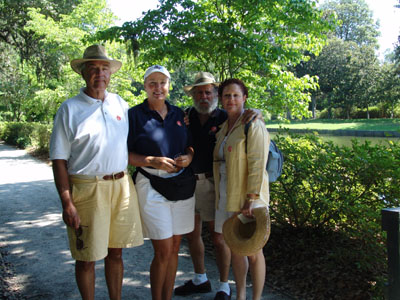|
BEAUFORT, SC TO CHARLESTON, SC TRAVELING THROUGH THE LOW COUNTRY AVOIDING THE MUD BOGS
We would be leaving Beaufort River now through
the old swing bridge and heading on up through Brickyard Creek. It was a curvy
Creek with a few narrow straight passages. Ocean Bear looked beautiful coming
through the swing bridge behind us.
We meandered up the peaceful creek lined with
salt marshes and trees when Ziggy started running around the decks barking
madly. We suddenly realized he was warning us that the jet skiers were coming.
They raced by with their loud motors, volumes of spray shooting our behind them
as they created wild patterns in the water with their wakes. Having made friends
with many of them at the docks, they all waved to us as they sped by like a pack
of hornets. In
other circumstances they perhaps would’ve been annoying to us with the loud
noises but now having had a chance to meet them we had a different opinion.
They were a group of really nice friendly people and we were pretty impressed at
the length of trip they had a head of them.
The trip to Charleston was pretty peaceful and
serene. There’s something about these salt marshes that is so mesmerizing.
They buffer you from civilization as not much can be built on them. They change
their appearance hourly as the tide comes and goes and it’s a never ending movie
to watch. I love how the wildlife, waterfowl, and insects, come and go with the
changing tides. I love how the gentle wind passes through the grasses and how
the colors change as the wind creates a flowing movement. I love the trees that
give the vista a reference point in the distance. I love the many channel
markers that the osprey have adopted by piling them amazingly high with sticks,
branches, and odds and ends, making a huge nest for their offspring. Some we’ve
seen even stuffed with corn cobs. These nests are truly amazing to see as we
pass them by. They are a real a work of art and to see their offspring right
there at eye level giving you a curious look as you pass by is beyond
description.
We watch nervously as the waters become shallow
or “skinny”, as they say here, when going around curves in the river where the
bottom has shoaled out. We learn to get a feel for the depths and its movement
in order to make our way. In long straight areas, we’ve managed the tricky
method of watching the markers behind and those ahead to keep ourselves straight
in the channel as the currents have a tendency to let you drift one way or the
other without you noticing it. Nothing is taken for granted because just when
you think things are easy going, along comes a tug or small barge right down the
narrow area ahead. How it always times out that way is amazing.
Again, we have to take into consideration the
tides so that we can traverse these areas safely. The tidal ranges in these
areas can range any where from 6 to 9 feet. It can be a serious event to run
aground at high tide or a falling tide as you may have to wait hours for the
high tide to come again before you can get off. Some boats having gone aground,
have been known not to get off the bottom again until the next moon or a
northeaster to give them enough depth. The danger occurs when you go aground
you have a tendency to lean over on your side and then have the risk of filling
with water when the next tide arrives. This would be in extreme cases, of
course, but reading about it in the guide gives one something to worry about.
We are amazed to see mile after mile of mounds
of empty white oyster shells on the river edges and some are so plentiful that
they create dangerous shoals. Are they ancient middens from Native Americans or
evidence of an over harvested industry with only the remains to show as a
reminder? It’s fun to imagine. We pass through most of the day without seeing
any houses. Occasionally we get a glimpse of what must be the Atlantic across
the protection of the marsh lands.
We begin to travel into a tricky area of our
trip as we leave Coosaw River and head into Ashepoo Coosaw Cut where we are
warned of many shallow shoaled areas not marked on the charts and other narrow
areas that we hope we don’t have oncoming traffic. We are trying to hug some
markers and give others a wide berth following the recommendations of our
cruising guide. Some of these shoaled areas are never ending as they keep
building over the years. The information, or warnings, is a little like “word of
mouth” or just plain “local knowledge” passed on. You just can’t trust the
charts completely. You must rely solely on the markers that may have been
changed by locals who know the conditions. These local changes will not be
reflected on your charts as they are not always up to date. Many times you’re
just praying that the currents haven’t just moved them in the wrong position. I
guess we just have to learn to accommodate and give in to the changing
occurrences of Mother Nature.
We begin to get a taste of civilization in a
sudden blunt manner as we make the tricky turn in Ashepoo Coosaw Cut at Rock
Creek. It is a shallow narrow area in the marsh lands with many sharp turns.
We had been anticipating this area but not the sudden occurrence of crab pots!
They were everywhere and mostly right in the center of the channel! We are
enraged and wondering who would have done this? It was hair raising. We called
on the radio to Ocean Bear and warned them of what we ahead. We had to keep the
boat in the channel without snagging on these things. We were amazed to see the
crab man in his boat on the side of the channel watching us go by. He waved at
us with out any shame as he baited and dropped another trap, knowing we must be
having a great deal of difficulty getting around these things.
As we left the narrow channel of Ashepoo River,
we turned and
As we approached the area of Limehouse Bridge
the small boat traffic became intense. Some of the recreational boaters were
oblivious to other boaters coming down the river and some would dart right out
in front of you without a concept of our inability to stop suddenly. Many had
their small day boats anchored in the shallow waters on the side of the river.
They really love to spend a nice summer day wading and swimming by their
anchored boat in the shallow water. I can only compare it to something like
tail gating at a football field. I guess it’s a way to cool off in the water
and at the same time spend it with their friends, drinking beer and enjoying
themselves.
As we got closer to Charleston the waterway
widened and the winds picked up making the water pretty choppy. We still had to
follow the channel markers as even though it was a broad water way, the sides
were shallow. We were surprised how the water suddenly became very choppy and
the afternoon winds picked up. A lot of the small recreational boats were
struggling to get home and some were heading in to shelter until the squall went
by. I
After a long day, we arrived at the Charleston
City Marina by crossing the Ashley River about 5:00 in the afternoon. It was a
huge marina. We felt very welcomed by the staff that efficiently handled our
lines and offered to help us with whatever we needed or answer any questions we
had. Ocean Bear came in right after us and docked nearby.
In Beaufort, as I mentioned earlier, we briefly
met Al and Sue, from Denver, on a Kroger called Toucan. They left before us in
Beaufort but as they chose to run slower than we normally do, we passed them
about mid day. It was fun to have two boats to talk to occasionally throughout
the day. They arrived shortly behind all of us and Sue didn’t waste much time
getting us all in agreement to go into Charleston for dinner that night. We
were all tired but she showed such energy ad enthusiasm, how could we resist?
Al & Sue invited all of us to their boat first for drinks before dinner. Joann and I mustered up some energy and got ready for the evening. Al & Sue’s boat’s interior was decorated to the hilt with themed palm trees complete right down to the napkins and dishes. It was elegant, fun and cozy. Afterwards, we all hopped into the marina shuttle van and had an elegant dinner at Anson’s. I recommended it as I read in the guide book that Mel Gibson loved it and frequented it many times while filming The Patriot. I thought if he likes it, what’s not to like? The food was divine and the company was even better. It was amazing that for six people who didn’t really know each other, we got along famously and had a really wonderful evening. We all squeezed into one cab on the way back to the marina with a jolly black lady cab driver . CHARLESTON
The next morning Al & Sue left at dawn. They were on a mission to get to Norfolk to store their boat. They had airline tickets to get back home to Denver so off they went. We waved goodbye and promised to keep in touch.
Charleston as everyone knows is a delight,
filled with beautiful architecture, wonderful restaurants and shops. You can
not have a great time there. We decided to rent a car to give us more freedom
to get around. We did our best to give ourselves a self tour.
C
There is a sense of mystery and folklore as you
wander past houses and small corner dinners that you have read about in the book
In the Garden of Evil. It’s amazing that the architecture is
still intact having survived, two wars, the Revolutionary War and Civil War,
almost burning to the ground and several serious hurricanes. It has survived
all this and still exudes an elegance of a time gone by.
Passing the Old City Market where now Gullah
ladies are weaving sweet grass baskets when once this was the auction market for
slaves. Streets are lined with world class restaurants and chic shops and
renowned antique stores. We wandered down the waterfront on Cooper River where
the old river warehouses have been restored and are now operating as restaurants
and shops and hotels. We admired the houses painted in different shades of
pastels on the river front and the parks paved with oyster shell paths. As we
walked the streets we saw many examples of beautiful architecture from Federal,
Adams and Greek revival.
We were fascinated by what they called the
“single house”. At one time Charleston based its taxes on the length of street
frontage so as a result to save money, they built the homes just a single room
width wide. Typically they built a veranda or porch on the side of the house
instead of the front. This porch stretches the length of the house and is
concealed by a single door. There may be room along this porch for just a
narrow strip of garden. They are unique to Charleston and still found all over
the city.
We also marveled at the number and variety of old churches and were reminded that from the city’s beginnings, this was a city known for religious tolerance. In it’s beginnings it started with a real mix from French Huguenots, Baptists, Jews, to Episcopalians all seeking a new life and freedom or worship.
There was much more to see and experience but not enough time on this visit.
MIDDLETON PLANTATION
Tomorrow we were off to Georgetown.
|
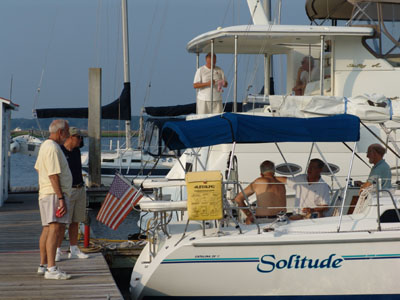 It
was a beautiful morning when we left. We hailed Ocean Bear on the radio and they
were just leaving their anchorage across the marshes and were heading around the
bend to join us to go through the Ladys Island Swing Bridge for its second
morning opening at 9:00. Another couple we met at the docks were Al & Sue on a
50 foot Krogen called “Toucan”. They were heading up to Charleston also. They
left an hour ahead but we said they’d be in touch by radio as the day went on.
We were not alone on the docks, as the jet skiers were starting their engines
and getting ready for their return trip north of Charleston.
It
was a beautiful morning when we left. We hailed Ocean Bear on the radio and they
were just leaving their anchorage across the marshes and were heading around the
bend to join us to go through the Ladys Island Swing Bridge for its second
morning opening at 9:00. Another couple we met at the docks were Al & Sue on a
50 foot Krogen called “Toucan”. They were heading up to Charleston also. They
left an hour ahead but we said they’d be in touch by radio as the day went on.
We were not alone on the docks, as the jet skiers were starting their engines
and getting ready for their return trip north of Charleston.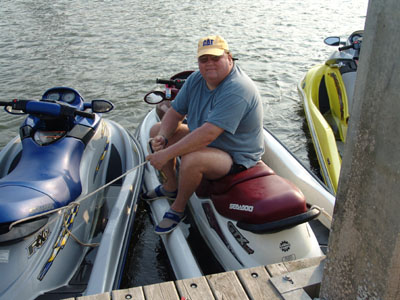
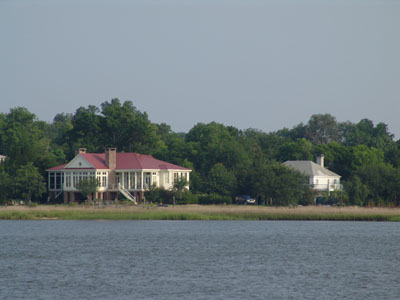 The
stately homes beyond the edge of the river were sheltered below the majestic
moss laden oak trees. We passed the house they used to film the The Big
Chill in and others that were equally as picturesque. Thank goodness
the Union army occupied this town during the Civil War, using it as their
headquarters and hospital zone, thereby preserving this wonderful place. A
visit here is a chance to step back in time, a beautiful time.
The
stately homes beyond the edge of the river were sheltered below the majestic
moss laden oak trees. We passed the house they used to film the The Big
Chill in and others that were equally as picturesque. Thank goodness
the Union army occupied this town during the Civil War, using it as their
headquarters and hospital zone, thereby preserving this wonderful place. A
visit here is a chance to step back in time, a beautiful time. 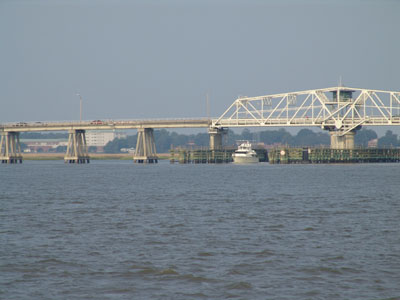
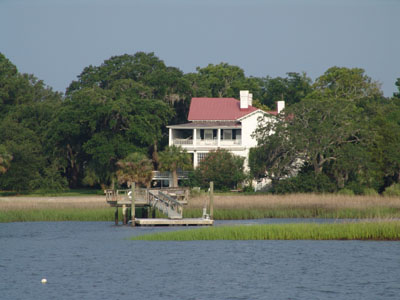
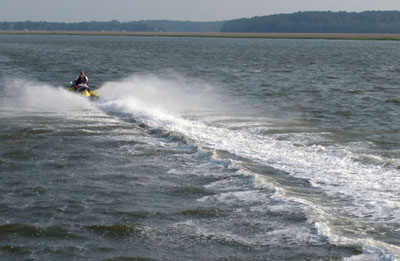
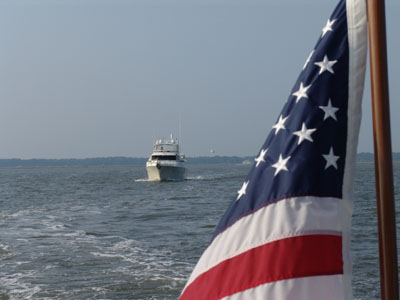
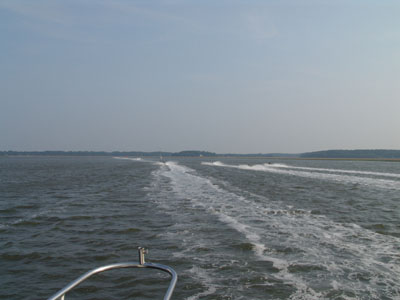 Larry was always calculating the effects of the tides and where we would be so
we would have the best advantage but sometimes no matter how much you plan, not
all can be perfect. Sometimes to travel in high tide conceals the visual twists
and turns of the river as the water fills into the marsh and deceives the
location of the true channel. Sometimes the movement of the tides and currents
pull the markers several feet off course during the ebb and flow, and all this
must be taken into account. You learn to develop a second sense to remember at
inlets, the shoals start to fill, and when the weather has been bad the same
thing happens but more extreme. You also learn that mud builds on the outer
curves of the river and so on. It’s a constant watch to stay out of the “mud
bog”.
Larry was always calculating the effects of the tides and where we would be so
we would have the best advantage but sometimes no matter how much you plan, not
all can be perfect. Sometimes to travel in high tide conceals the visual twists
and turns of the river as the water fills into the marsh and deceives the
location of the true channel. Sometimes the movement of the tides and currents
pull the markers several feet off course during the ebb and flow, and all this
must be taken into account. You learn to develop a second sense to remember at
inlets, the shoals start to fill, and when the weather has been bad the same
thing happens but more extreme. You also learn that mud builds on the outer
curves of the river and so on. It’s a constant watch to stay out of the “mud
bog”.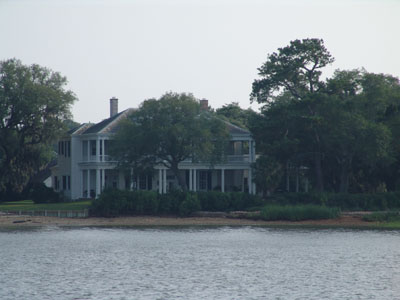
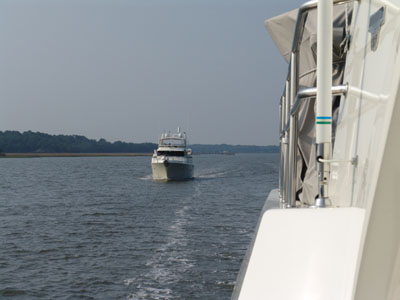
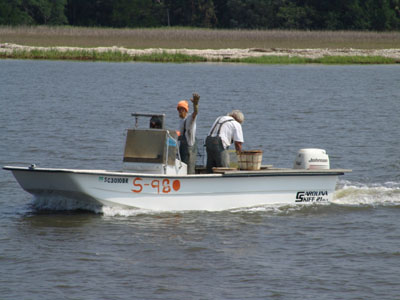 He was a ragged looking character in his dirty overalls. He was cocky with his
cigarette hanging out of his mouth as he smirked at us, probably chuckling to
himself. I think sometimes the local watermen think we recreational boaters are
a pain in the "you know what" and put a crimp into their lifestyle. I’m sure he
enjoyed watching us struggle through his mazelike minefield. When we arrived
in Charleston we heard other boaters complaining about him and his crab pots.
We all somehow
managed to get by them safely as it seems everyone does.
He was a ragged looking character in his dirty overalls. He was cocky with his
cigarette hanging out of his mouth as he smirked at us, probably chuckling to
himself. I think sometimes the local watermen think we recreational boaters are
a pain in the "you know what" and put a crimp into their lifestyle. I’m sure he
enjoyed watching us struggle through his mazelike minefield. When we arrived
in Charleston we heard other boaters complaining about him and his crab pots.
We all somehow
managed to get by them safely as it seems everyone does.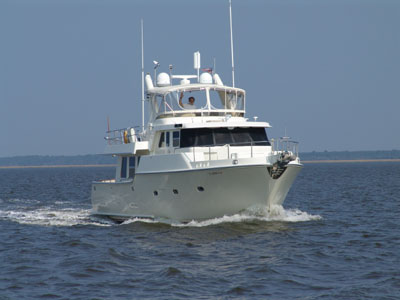
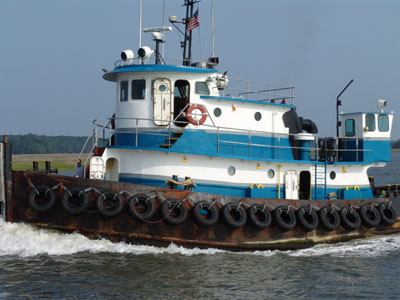 entered
the wide portion of South Edisto River by the Fenwick Cut. This was the first
time we started to encounter speeding power boats passing us. It was we guessed
our first sign of civilization again. We had a few low bridges ahead that
required openings as we were getting closer to Charleston. We were gauging our
arrival time to hopefully occur with the scheduled bridge openings. It
was a job just to figure out which ones opened on a schedule and what the
schedule was and then which ones didn’t open on a schedule but from your call on
the radio. You also had to find out what each one's vertical clearance was to
make sure you required an opening because if you have them open and you could’ve
made it under, you can get a hefty fine. We began to see more and more houses
on the river each with their own private docks which required us to keep close
watch on our wake.
entered
the wide portion of South Edisto River by the Fenwick Cut. This was the first
time we started to encounter speeding power boats passing us. It was we guessed
our first sign of civilization again. We had a few low bridges ahead that
required openings as we were getting closer to Charleston. We were gauging our
arrival time to hopefully occur with the scheduled bridge openings. It
was a job just to figure out which ones opened on a schedule and what the
schedule was and then which ones didn’t open on a schedule but from your call on
the radio. You also had to find out what each one's vertical clearance was to
make sure you required an opening because if you have them open and you could’ve
made it under, you can get a hefty fine. We began to see more and more houses
on the river each with their own private docks which required us to keep close
watch on our wake.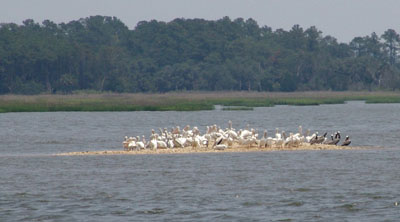
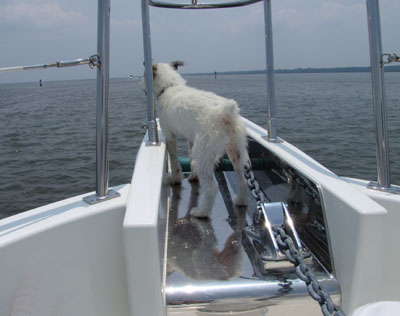
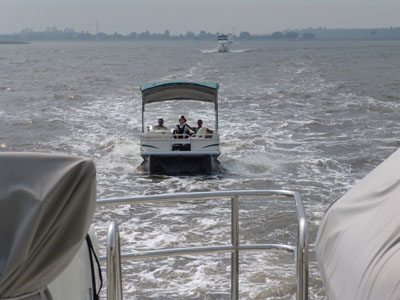 happened to look behind us and noticed one boat who was riding right on our tail
in the flat between our side wakes. He was taking advantage of the calm
waters immediately behind us. We thought he was pretty clever. He got a
free ride for several miles.
happened to look behind us and noticed one boat who was riding right on our tail
in the flat between our side wakes. He was taking advantage of the calm
waters immediately behind us. We thought he was pretty clever. He got a
free ride for several miles.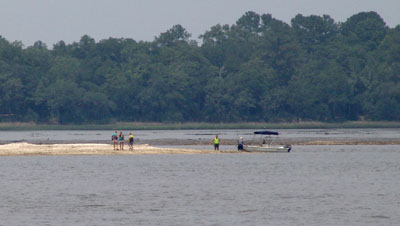
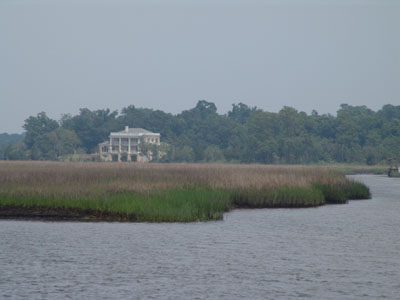 I
was really impressed to see that Joann docked the boat. They have head phones
that enable them to talk to each other as they do this. Steve handles the lines
and gives directions and it seems to work really well. We really enjoyed
traveling with Ocean Bear and talking occasionally on the radio about the
conditions ahead or the beautiful scenery. It was also helpful when Steve would
call us and warn of a speed boat coming upon us from behind so we could prepare
for the wake in some of the narrow channels.
I
was really impressed to see that Joann docked the boat. They have head phones
that enable them to talk to each other as they do this. Steve handles the lines
and gives directions and it seems to work really well. We really enjoyed
traveling with Ocean Bear and talking occasionally on the radio about the
conditions ahead or the beautiful scenery. It was also helpful when Steve would
call us and warn of a speed boat coming upon us from behind so we could prepare
for the wake in some of the narrow channels.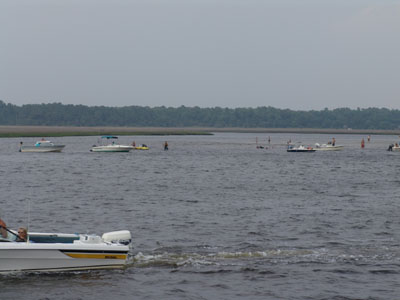
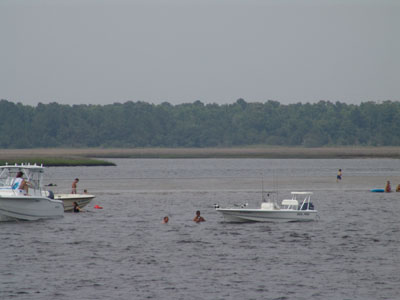
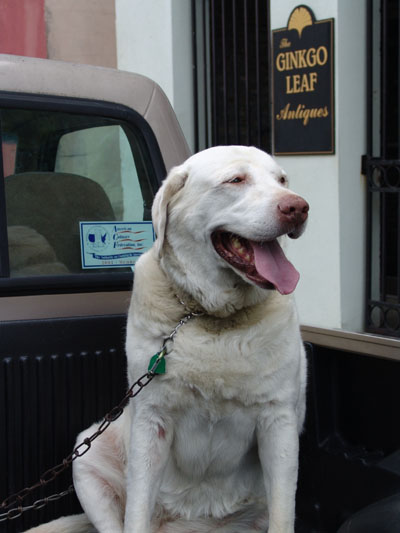 We planned to stay 3 days in Charleston. Larry
found a nice young man to wash the boat and he did a really thorough job and we
were really pleased. We took the first day to get laundry done and clean the
boat, inside and out. Al & Sue, and Joann and Steve spent the day touring and
walking the streets of Charleston. That evening we were all invited to Ocean
Bear for drinks and appetizers and then dinner at Magnolia’s. Again we had a
great dinner and great company and again the same jolly black lady cab driver on
the way home. She chuckled the whole way back to the marina.
We planned to stay 3 days in Charleston. Larry
found a nice young man to wash the boat and he did a really thorough job and we
were really pleased. We took the first day to get laundry done and clean the
boat, inside and out. Al & Sue, and Joann and Steve spent the day touring and
walking the streets of Charleston. That evening we were all invited to Ocean
Bear for drinks and appetizers and then dinner at Magnolia’s. Again we had a
great dinner and great company and again the same jolly black lady cab driver on
the way home. She chuckled the whole way back to the marina.
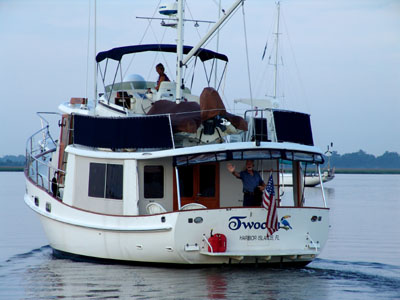
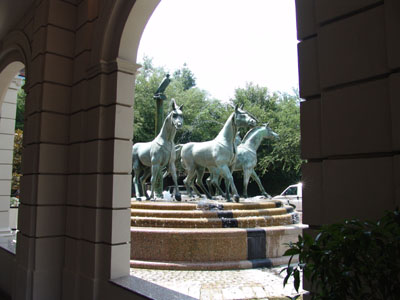 harleston
exudes southern living. Besides the southern drawl, and chivalrous
manners, the homes stand proud and beautiful. There are many wonderful
gardens with blooming magnolias, white and pink crepe myrtle, beautiful puffy
hydrangeas and the air is filled with the fragrance of jasmine. We wandered the
streets and neighborhoods admiring their formal hedged gardens hidden behind
lace-like iron fences and gates. You walk by grand pillars leading into
opulent homes full of generations of history. You never get tired dining
on "low country cuisine" nor do you feel guilty about eating it as everyone
joining you in the sin of hit fat consumption.
harleston
exudes southern living. Besides the southern drawl, and chivalrous
manners, the homes stand proud and beautiful. There are many wonderful
gardens with blooming magnolias, white and pink crepe myrtle, beautiful puffy
hydrangeas and the air is filled with the fragrance of jasmine. We wandered the
streets and neighborhoods admiring their formal hedged gardens hidden behind
lace-like iron fences and gates. You walk by grand pillars leading into
opulent homes full of generations of history. You never get tired dining
on "low country cuisine" nor do you feel guilty about eating it as everyone
joining you in the sin of hit fat consumption.
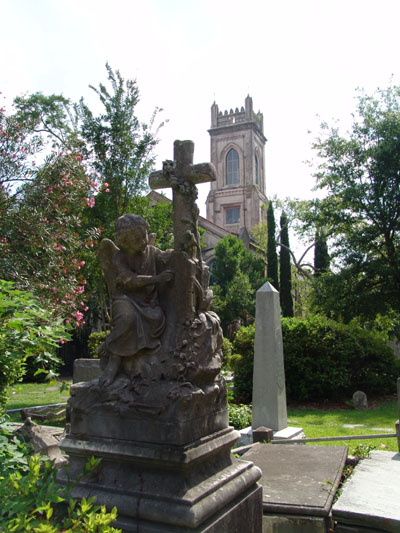
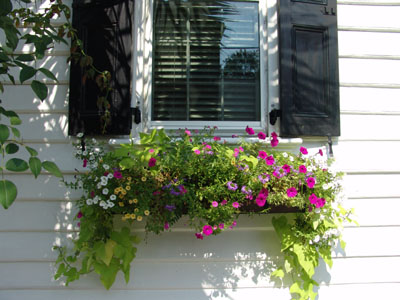
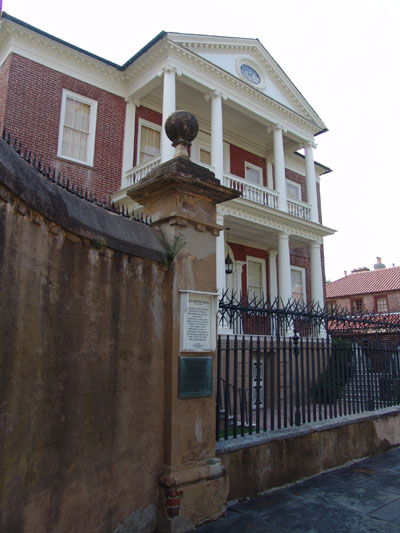
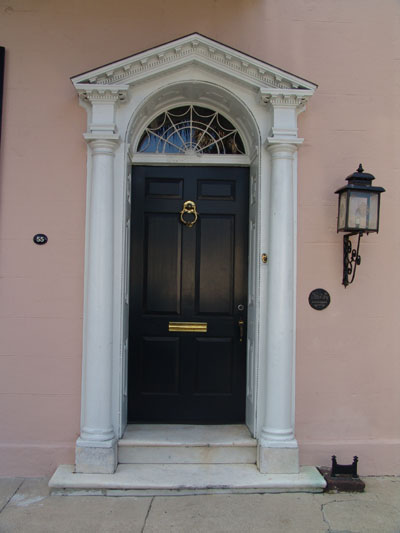
 The
pineapples motif is everywhere, from door knockers, caps on pillars, wallpaper,
etc. It’s long been known as a symbol of hospitality and wealth.
The
pineapples motif is everywhere, from door knockers, caps on pillars, wallpaper,
etc. It’s long been known as a symbol of hospitality and wealth. 